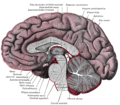Posterior commissure
Posterior commissure (PC) is a small rounded fiber bundle crossing the midline of the brain. It is located at the junction of the thalamus and midbrain and is part of the epithalamus. It plays a role in bilateral pupillary light reflex and is involved in the coordination of eye movements.
Anatomy[edit]
The posterior commissure is located near the pineal gland, above the cerebral aqueduct and below the habenular commissure. It is composed of commissural fibers that cross the midline of the brain. The fibers originate from several areas of the brain, including the superior colliculus, pretectal area, and medial geniculate body.
Function[edit]
The posterior commissure is involved in several functions. It plays a role in the bilateral pupillary light reflex, which is the constriction of both pupils in response to light shone in one eye. This reflex is mediated by the Edinger-Westphal nucleus, which sends fibers to the posterior commissure.
The posterior commissure also plays a role in the coordination of eye movements. It is involved in the vertical gaze system, which allows for upward and downward movements of the eyes. The fibers of the posterior commissure connect the rostral interstitial nucleus of the medial longitudinal fasciculus (riMLF) on one side of the brain to the oculomotor and trochlear nuclei on the other side, allowing for coordinated vertical eye movements.
Clinical significance[edit]
Damage to the posterior commissure can result in several neurological disorders. These include Parinaud's syndrome, which is characterized by an inability to move the eyes upward, and Argyll Robertson pupil, which is a disorder of the pupillary light reflex.
See also[edit]
References[edit]
<references />
Ad. Transform your life with W8MD's Budget GLP-1 injections from $75


W8MD offers a medical weight loss program to lose weight in Philadelphia. Our physician-supervised medical weight loss provides:
- Weight loss injections in NYC (generic and brand names):
- Zepbound / Mounjaro, Wegovy / Ozempic, Saxenda
- Most insurances accepted or discounted self-pay rates. We will obtain insurance prior authorizations if needed.
- Generic GLP1 weight loss injections from $75 for the starting dose.
- Also offer prescription weight loss medications including Phentermine, Qsymia, Diethylpropion, Contrave etc.
NYC weight loss doctor appointmentsNYC weight loss doctor appointments
Start your NYC weight loss journey today at our NYC medical weight loss and Philadelphia medical weight loss clinics.
- Call 718-946-5500 to lose weight in NYC or for medical weight loss in Philadelphia 215-676-2334.
- Tags:NYC medical weight loss, Philadelphia lose weight Zepbound NYC, Budget GLP1 weight loss injections, Wegovy Philadelphia, Wegovy NYC, Philadelphia medical weight loss, Brookly weight loss and Wegovy NYC
|
WikiMD's Wellness Encyclopedia |
| Let Food Be Thy Medicine Medicine Thy Food - Hippocrates |
Medical Disclaimer: WikiMD is not a substitute for professional medical advice. The information on WikiMD is provided as an information resource only, may be incorrect, outdated or misleading, and is not to be used or relied on for any diagnostic or treatment purposes. Please consult your health care provider before making any healthcare decisions or for guidance about a specific medical condition. WikiMD expressly disclaims responsibility, and shall have no liability, for any damages, loss, injury, or liability whatsoever suffered as a result of your reliance on the information contained in this site. By visiting this site you agree to the foregoing terms and conditions, which may from time to time be changed or supplemented by WikiMD. If you do not agree to the foregoing terms and conditions, you should not enter or use this site. See full disclaimer.
Credits:Most images are courtesy of Wikimedia commons, and templates, categories Wikipedia, licensed under CC BY SA or similar.
Translate this page: - East Asian
中文,
日本,
한국어,
South Asian
हिन्दी,
தமிழ்,
తెలుగు,
Urdu,
ಕನ್ನಡ,
Southeast Asian
Indonesian,
Vietnamese,
Thai,
မြန်မာဘာသာ,
বাংলা
European
español,
Deutsch,
français,
Greek,
português do Brasil,
polski,
română,
русский,
Nederlands,
norsk,
svenska,
suomi,
Italian
Middle Eastern & African
عربى,
Turkish,
Persian,
Hebrew,
Afrikaans,
isiZulu,
Kiswahili,
Other
Bulgarian,
Hungarian,
Czech,
Swedish,
മലയാളം,
मराठी,
ਪੰਜਾਬੀ,
ગુજરાતી,
Portuguese,
Ukrainian





